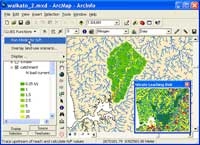CLUES to impacts of land-use change

The "CLUES" toolbox in ArcMap, displaying nitrate loads from a model run together with a sub-window showing nitrate leaching risk in that area.
A team of scientists from AgResearch, NIWA, Landcare Research, HortResearch, Harris Consulting, and Aqualinc Ltd., continue to develop a powerful new tool to help predict the impacts of land-use changes on water quality and socio-economic indicators. CLUES – the Catchment Land Use for Environmental Sustainability system – models nitrogen and phosphorus loads in streams in specific locations under different land-use scenarios. Links to socio-economic models mean that the effects of a large-scale change in land-use, say from grazing livestock to viticulture, on local communities can also be predicted.
The CLUES project has included creating national maps of land use, soils, and pollution risk, plus extensive databases predicting nitrogen leaching for many combinations of crop, fertiliser, climate, and soils. Land-use types which can be analysed include arable, horticulture, forestry, and several sheep, beef, dairy, and deer farming variations.
The initial impetus for CLUES’ development came from MAF, who wanted ‘what if’ scenarios to be modelled at large scales. A number of existing modelling and mapping procedures, developed by various research organisations, have been amalgamated to produce CLUES. This first stage of the work, funded by the Cross Departmental Research Pool, is nearing completion.
The next phase of the project, funded by FRST’s EnviroLink and Pastoral 21, will involve making the system more suitable for use by regional agencies – for example, by incorporating seasonality, predicted microbe and sediment changes in water courses, and local calibrations of the underlying water quality prediction model.
